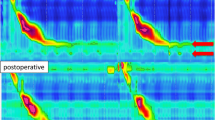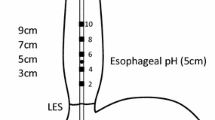Abstract
Background
The modalities for evaluating acid reflux in medical care for gastroesophageal reflux disease (GERD) include conventional pH (C-pH), wireless pH (Bravo®) and multichannel intraluminal impedance pH (MII-pH), which have been reported to vary with respect to the duration of acid reflux. In this study, we examined the difference between the acid reflux in C-pH and MII-pH among patients with GERD.
Methods
Prior to initial laparoscopic fundoplication carried out on 297 cases from December 1994 to April 2016, an upper gastrointestinal endoscopy and C-pH or MII-pH were conducted. A propensity score-matched analysis was carried out about five factors including age, sex, BMI, the extent of reflux esophagitis (Los Angeles classification), and the presence of hiatal hernia (HH), ultimately leading to the creation of a C-pH group (81 cases) and MII-pH group (81 cases) as the subjects.
Results
Concerning pH < 4 holding time (18.9 vs. 7.3%, p < 0.001), DeMeester score (58.5 vs. 24.4, p < 0.001), and the number of times reflux continued for longer than 5 min (8.8 vs. 4.1 times/day, p = 0.002), the C-pH group had significantly higher values for each, while the positive rate of acid reflux (Positive pH) was significantly higher in the C-pH group (p < 0.001), at 80% in the C-pH group and 42% in the MII-pH group. In terms of the correlation between the extent of reflux esophagitis and pH < 4 holding time, a moderate level of positive correlation was seen in both the C-pH group and MII-pH group (r of each = 0.427, r = 0.408); moreover, regardless of the presence of HH, the holding time was significantly higher in the C-pH group than the MII-pH group (p of each <0.001, p = 0.040).
Conclusion
While the values of each parameter regarding acid reflux are calculated as lower in MII-pH than in C-pH, there is no difference in the evaluation of the pathology between the two modalities.






Similar content being viewed by others

References
Johnson LF, Demeester TR (1974) Twenty-four-hour pH monitoring of the distal esophagus. A quantitative measure of gastroesophageal reflux. Am J Gastroenterol 62(4):325–332
Hirano I (2006) Review article: modern technology in the diagnosis of gastro-oesophageal reflux disease—Bilitec, intraluminal impedance and Bravo capsule pH monitoring. Aliment Pharmacol Ther 23(Suppl 1):12–24
Wise JL, Murray JA (2007) Utilising multichannel intraluminal impedance for diagnosing GERD: a review. Dis Esophagus 20(2):83–88
Mishima I, Adachi K, Arima N, Amano K, Takashima T, Moritani M, Furuta K, Kinoshita Y (2005) Prevalence of endoscopically negative and positive gastroesophageal reflux disease in the Japanese. Scand J Gastroenterol 40(9):1005–1009
Shay S, Tutuian R, Sifrim D, Vela M, Wise J, Balaji N, Zhang X, Adhami T, Murray J, Peters J, Castell D (2004) Twenty-four hour ambulatory simultaneous impedance and pH monitoring: a multicenter report of normal values from 60 healthy volunteers. Am J Gastroenterol 99(6):1037–1043
Xiao YL, Lin JK, Cheung TK, Wong NY, Yang L, Hung IF, Wong BC, Chen MH (2009) Normal values of 24-hour combined esophageal multichannel intraluminal impedance and pH monitoring in the Chinese population. Digestion 79(2):109–114
Han MS, Lada MJ, Nieman DR, Tschoner A, Peyre CG, Jones CE, Watson TJ, Peters JH (2015) 24-h multichannel intraluminal impedance-pH monitoring may be an inadequate test for detecting gastroesophageal reflux in patients with mixed typical and atypical symptoms. Surg Endosc 29(7):1700–1708
Yano F, Omura N, Tsuboi K, Hoshino M, Yamamoto SR, Akimoto S, Masuda T, Mitsumori N, Kashiwagi H, Yanaga K (2017) Standard values of 24-h multichannel intraluminal impedance-pH monitoring for the Japanese. Esophagus 14(1):91–96
Ndebia EJ, Sammon AM, Umapathy E, Iputo JE (2016) Normal values of 24-hour ambulatory esophageal impedance-pH monitoring in a rural South African cohort of healthy participants. Dis Esophagus 29(4):385–391
Lord RV, DeMeester SR, Peters JH, Hagen JA, Elyssnia D, Sheth CT, DeMeester TR (2009) Hiatal hernia, lower esophageal sphincter incompetence, and effectiveness of Nissen fundoplication in the spectrum of gastroesophageal reflux disease. J Gastrointest Surg 13(4):602–610
Pandolfino JE, Schreiner MA, Lee TJ, Zhang Q, Boniquit C, Kahrilas PJ (2005) Comparison of the Bravo wireless and Digitrapper catheter-based pH monitoring systems for measuring esophageal acid exposure. Am J Gastroenterol 100(7):1466–1476
Hila A, Agrawal A, Castell DO (2007) Combined multichannel intraluminal impedance and pH esophageal testing compared to pH alone for diagnosing both acid and weakly acidic gastroesophageal reflux. Clin Gastroenterol Hepatol 5(2):172–177
Ott DJ, Glauser SJ, Ledbetter MS, Chen MY, Koufman JA, Gelfand DW (1995) Association of hiatal hernia and gastroesophageal reflux: correlation between presence and size of hiatal hernia and 24-hour pH monitoring of the esophagus. AJR Am J Roentgenol 165(3):557–559
Patti MG, Goldberg HI, Arcerito M, Bortolasi L, Tong J, Way LW (1996) Hiatal hernia size affects lower esophageal sphincter function, esophageal acid exposure, and the degree of mucosal injury. Am J Surg 171(1):182–186
Jones MP, Sloan SS, Rabine JC, Ebert CC, Huang CF, Kahrilas PJ (2001) Hiatal hernia size is the dominant determinant of esophagitis presence and severity in gastroesophageal reflux disease. Am J Gastroenterol 96(6):1711–1717
Emerenziani S, Habib FI, Ribolsi M, Caviglia R, Guarino MP, Petitti T, Cicala M (2006) Effect of hiatal hernia on proximal oesophageal acid clearance in gastro-oesophageal reflux disease patients. Aliment Pharmacol Ther 23(6):751–757
Lundell LR, Dent J, Bennett JR, Blum AL, Armstrong D, Galmiche JP, Johnson F, Hongo M, Richter JE, Spechler SJ, Tytgat GN, Wallin L (1999) Endoscopic assessment of oesophagitis: clinical and functional correlates and further validation of the Los Angeles classification. Gut 45(2):172–180
Miwa H, Yokoyama T, Hori K, Sakagami T, Oshima T, Tomita T, Fujiwara Y, Saita H, Itou T, Ogawa H, Nakamura Y, Kishi K, Murayama Y, Hayashi E, Kobayashi K, Tano N, Matsushita K, Kawamoto H, Sawada Y, Ohkawa A, Arai E, Nagao K, Hamamoto N, Sugiyasu Y, Sugimoto K, Hara H, Tanimura M, Honda Y, Isozaki K, Noda S, Kubota S, Himeno S (2008) Interobserver agreement in endoscopic evaluation of reflux esophagitis using a modified Los Angeles classification incorporating grades N and M: a validation study in a cohort of Japanese endoscopists. Dis Esophagus 21(4):355–363
Author information
Authors and Affiliations
Corresponding author
Ethics declarations
Disclosures
Drs. Masato Hoshino, Nobuo Omura, Fumiaki Yano, Kazuto Tsuboi, Se Ryung Yamamoto, Shunsuke Akimoto, Takahiro Masuda, Hideyuki Kashiwagi and Katsuhiko Yanaga have no conflicts of interest or financial ties to disclose.
Rights and permissions
About this article
Cite this article
Hoshino, M., Omura, N., Yano, F. et al. Comparison of the multichannel intraluminal impedance pH and conventional pH for measuring esophageal acid exposure: a propensity score-matched analysis. Surg Endosc 31, 5241–5247 (2017). https://doi.org/10.1007/s00464-017-5595-9
Received:
Accepted:
Published:
Issue Date:
DOI: https://doi.org/10.1007/s00464-017-5595-9



